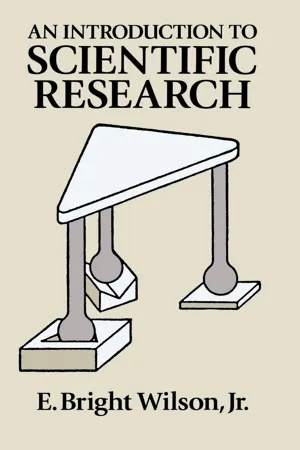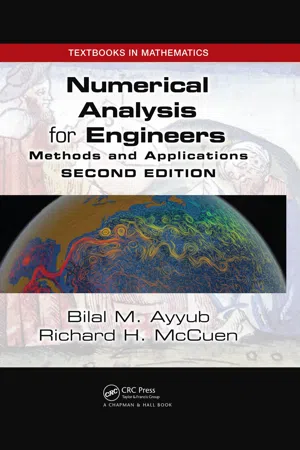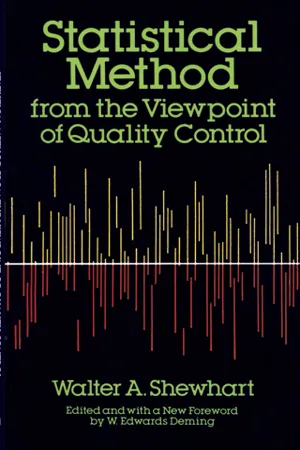Mathematics
Limits of Accuracy
Limits of accuracy refer to the maximum possible error or uncertainty in a measurement or calculation. It is determined by the precision of the measuring instrument or the accuracy of the mathematical model used. The concept of limits of accuracy is important in ensuring the reliability and validity of scientific and mathematical results.
Written by Perlego with AI-assistance
Related key terms
Related key terms
1 of 4
Related key terms
1 of 3
3 Key excerpts on "Limits of Accuracy"
- eBook - ePub
- E. Bright Wilson(Author)
- 2012(Publication Date)
- Dover Publications(Publisher)
Sec. 7.8 ) in order to eliminate any systematic error due to approximations in the theory. Each parameter entering would have to be measured on each repetition by independent reference right back to the primary standards of length, time, etc. To carry out such a program rigorously is clearly impractical, but the scheme does suggest ways in which improvements can be obtained in practical situations.Finally, the reader is urged to regard these considerations as applicable not only to measurements of great accuracy but quite generally. They are, in fact, just as applicable when only an order of magnitude is wanted, provided only that methods are not available which give considerably greater accuracy than that needed.It is probably undesirable to adopt the philosophy of one workman who was assigned the job of measuring a cable used in an underwater experiment. When asked if he had repeated the measurement as a check, he replied, “Naw, if you measure it once, you know what you’ve got. If you measure it again and don’t get the same answer, you don’t know where you are.”9.7. Ways of Expressing Limits of ErrorA numerical measure is useless for practical purposes unless some idea of its reliability is available. The experimenter who obtains the measure is clearly in the best position to supply this estimate of the limits of error, and it is therefore his duty to do so. It is also important that he make clear the meaning of the limits which he supplies.In the previous sections the basis for estimating error limits has been given These limits should include not only the effect of random errors but also the observer’s best judgment as to the possible influence of assignable causes and systematic errors. Since these latter do not follow any statistical law and can only be evaluated on the basis of knowledge and experience with a particular method, it is usually not possible to express the limits of error in terms of confidence intervals with any particular level of confidence. Often published limits represent the experimenter’s judgment of a range which is highly likely to include the true value. - eBook - ePub
Numerical Analysis for Engineers
Methods and Applications, Second Edition
- Bilal Ayyub, Richard H. McCuen(Authors)
- 2015(Publication Date)
- Chapman and Hall/CRC(Publisher)
accuracy is the degree to which the measurements deviate from the true value. If the deviations are small, then the method or process that led to the measurement is accurate.With reference to the numerical method of Example 3.1 , it provides accurate estimates because it closely approaches the true value regardless of the initial estimate. If the method consistently led to estimates that exceeded the true value by some amount δ, then the numerical method would have a positive bias of δ. If the estimates were consistently less than the true value by an amount δ, then the bias would be negative. If the deviations were often greater than the true value and just as often less than the true value, then the method would be imprecise and inaccurate.Table 3.1 provides a summary of the concepts of accuracy, precision, and bias as they characterize the holes in the targets of Figure 3.2 . Of course, terms like high, moderate, and low are somewhat subjective. Statistical measures of systematic and nonsystematic variations are provided in usage for particular applications.TABLE 3.1 Summary of Bias, Precision, and Accuracy for Figure 3.2Target Bias Precision Accuracy A None (unbiased) High High B High High Low C None (unbiased) Low Low D Moderate Low Low 3.3 Significant Figures
Consider the problem of measuring the distance between two points using a ruler that has a scale with 1 mm between the finest divisions. If we record our measurements in centimeters and if we estimate fractions of a millimeter, then a distance recorded as 3.76 cm gives two precise digits (i.e., the 3 and the 7) and one estimated digit (i.e., the 6). If we define a significant digit to be any number that is relatively precise, then the measurement of 3.76 cm has three significant digits. Even though the last digit could be a 5 or a 7, it still provides some information about the length, so it is assumed to be significant. If we recorded the number as 3.762, we would still have only three significant digits since the 2 is not precise. Only one imprecise digit can be considered as a significant digit. - Walter A. Shewhart(Author)
- 2012(Publication Date)
- Dover Publications(Publisher)
. Usually, however, accuracy is thought of in terms of more than one operation of measurement, because the term true value usually implies consistency among all the infinite sequences corresponding to different methods of measurement (cf. sequences (11), p. 72).FIG. 31The first point I wish to make is that the ranges used in defining the classical concepts of both accuracy and precision are of the tolerance type in that they are constant ranges conceived of as being tied down to fixed points .It should also be noted that the operational meanings of accuracy and precision are more involved than that of either X ′ or in that even after these symbols have been given meaning, we must yet consider the operational meaning of p′. Of course, we can logically conceive of the fraction p′ associated with any fixed range. However, it is not so easy to conceive of an operation either physical or formal by which one could obtain p′ from a given observed sequence. In practice, we often think of the fraction p of the first n numbers of an observed sequence and speak of the statistical limit of p as n approaches ∞ as being equal to p′. However, as previously pointed out, this concept of a limit does not provide any formal process of determining how close p approaches p′ for any chosen value of n. Hence p ′ is not formally defined in an operational way other than to say that it may be thought of in much the same way that a true value X ′ may be thought of, even though we are not able to conceive of an operation of finding either p′ or X′.Enough has been said to show that the symbols p ′, X ′, and entering into the classical definitions of accuracy and precision stand for logical concepts that are neither practically nor physically verifiable. Likewise the concept of degree of rational belief p ′b relating evidence E to a prediction P
Index pages curate the most relevant extracts from our library of academic textbooks. They’ve been created using an in-house natural language model (NLM), each adding context and meaning to key research topics.
Explore more topic indexes
Explore more topic indexes
1 of 6
Explore more topic indexes
1 of 4


